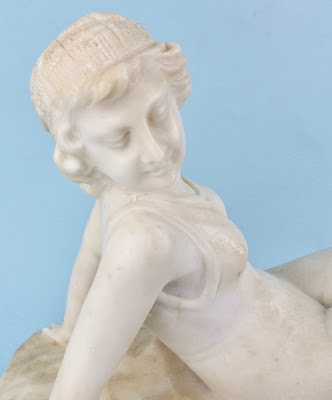Nor scar that whiter skin of hers than snow
And smooth as monumental alabaster.
Othello, Act 5, Scene 2, William Shakespeare
This statuesque bathing beauty is sculpted out of alabaster. Fine alabaster closely resembles white marble, but is a much softer stone, allowing it to be carved into detailed designs (however, the porous stone is soluble in water, making it unsuitable for fountains and outdoor decor). Italy, where alabaster has been mined and carved for centuries, provided copious copies of ancient carvings or classical subjects for the Victorian home and to the growing population of middle class tourists taking in the sights on their own grand tours. However, beginning in the late 1800s, Italian artists revitalized their industry by sculpting their own creations in the Orientalist, art nouveau, and art deco genres. In the 1920s Italian alabaster lamps, both as ceiling fixtures and as softly-lit boudoir lamps, often incorporating a nude nymph or flirtatious flapper, became a popular decorative item. Although unsigned, this alabaster bathing belle is undoubtedly of Italian birth, probably dating from the 1920s. This sculpted seaside siren is 12.5 inches long and 9 inches high.
Her thigh-length tank suit is etched with a floral design and a scarf covers her carved curls. Alabaster is subject to dings and can break easily; at one point it looks like someone tried to repair a crack in the base with glue. Oils, including from exploring fingers, smoke, and water can stain or discolor the stone, so cleaning alabaster is difficult. Unless you want to incur the expense of a professional restorer, is best just to gently dust it thoroughly with a soft-bristle brush and buff it lightly with a microfiber cloth, letting it retain its well-earned patina.




No comments:
Post a Comment